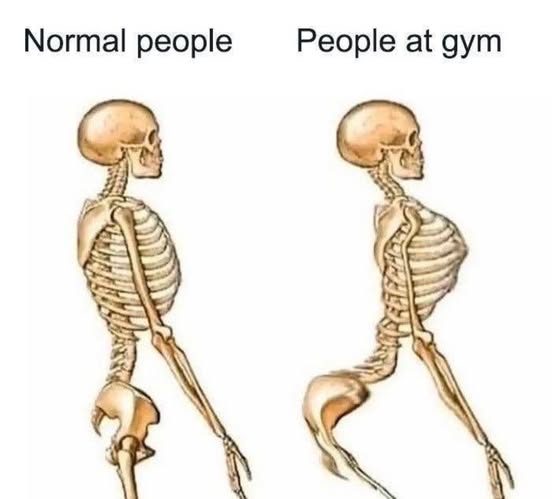Let’s be real—hitting the gym doesn’t just change how you feel or look. Apparently, it also changes how you carry yourself—literally. There’s a viral meme floating around that hilariously sums up what happens to many fitness lovers, especially after leg day. It compares a regular skeleton to a “gym person” skeleton, where the latter struts with an exaggerated arch, puffed-out chest, and hips pushed forward like they’re on a runway. If you’ve been to the gym or just scrolled fitness TikTok, chances are you’ve seen—or even become—this skeleton.

This meme is funny because it’s painfully accurate. What starts as proper form quickly morphs into a dramatic display of pride. You’re sore, your glutes are on fire, and suddenly, you can’t help but walk like a superhero in slow motion. It’s not about showing off—it’s about surviving and secretly hoping someone notices how hard you trained.
Let’s unpack the science, psychology, and comedy behind the infamous “leg day strut” and the internet’s favorite gym meme.
Why Everyone Starts Walking Like a Model After Leg Day
There’s something oddly theatrical that happens after a brutal leg workout. As you leave the gym, you find yourself walking with more intention. Your chest leads, your back arches, and your glutes engage like you’re showing off for an invisible audience. Why? Because leg day hits different.
This isn’t just a random physical reaction—it’s a blend of soreness, pride, and the natural high of pushing your limits. When you crush a heavy squat or deadlift session, your posture often reflects that accomplishment. What starts as a result of muscle fatigue and good form can quickly become exaggerated. The arch in your back gets deeper, your stride gets wider, and suddenly, you’re telling the world, “I hit PRs today.”
The Meme That Captures It All
The internet doesn’t miss a beat when it comes to capturing the human experience in a single image. This meme features two skeletons: one looking chill and neutral, the other strutting with a hyper-arched back and dramatic hip tilt. It’s both hilarious and strangely relatable.
We laugh because it’s us. If you’ve spent any time in a public gym, you’ve seen this transformation in real-time. You might’ve even felt your own spine silently agreeing with the meme. It’s part self-awareness, part shared gym culture. And that’s why it resonates so widely.
What’s Really Going On With That Posture?
Let’s break this down with a bit of anatomy. What the meme exaggerates is something known as anterior pelvic tilt. That’s when your hips tilt forward, making your lower back arch more than normal. While this can happen from sitting too long, it’s also common in gym-goers who hit squats hard but neglect stretching or core work.
After a heavy leg session, especially with exercises like squats or Romanian deadlifts, many people instinctively adopt what’s known as a “power posture.” It’s shoulders back, chest up, glutes tight. It’s not just for show—it’s how your body responds to the stress you just put it through. And yes, it can look like you’re trying to land a modeling gig at the gym.
The Psychology of the Post-Workout Swagger
Beyond the physical mechanics, there’s also a powerful psychological shift at play. Gym culture is as much about identity as it is about fitness. You train consistently, you fuel your body, and over time, you build not just strength but confidence.
That exaggerated strut after a big lift isn’t just about sore muscles—it’s about pride. It’s a non-verbal announcement: “I’ve earned this posture.” There’s a deep human desire to have our efforts recognized, and in the gym, sometimes our walk becomes our trophy.
Social Media’s Role in the Gym Swagger Trend
Of course, TikTok, Instagram, and YouTube have turned the gym into a stage. Fitness influencers often strut into the gym like they’re on a fashion runway. With every “fit check” video or mirror selfie, exaggerated posture becomes the new normal. Before long, even your skeleton gets the memo.
We learn by mimicking. And when the top gym content creators constantly showcase arched backs and tight glutes, it makes sense that average gym-goers adopt similar postures—both consciously and unconsciously.
How to Rock the Gym Look Without Becoming a Meme
Listen, no judgment here. The gym skeleton meme is funny because we’ve all been that guy or girl. But if you want to enjoy the gains without compromising your long-term posture or becoming the next viral joke, here are a few quick tips:
-
Strengthen Your Core: A solid core stabilizes your spine and prevents exaggerated arching. Don’t skip planks, dead bugs, and reverse crunches.
-
Prioritize Stretching: After leg day, give some love to your hip flexors, quads, and hamstrings. Ten minutes of focused stretching can ease tension and realign your posture.
-
Practice Mindful Walking: It’s cool to walk with confidence, but try not to overdo it like you’re filming a protein shake commercial.
-
Use Humor as a Tool: If you catch yourself mid-glute-flex walking past a mirror, laugh it off. Then reset your posture and keep striding.
-
Stay Grounded in Confidence, Not Ego: It’s awesome to feel strong. Just don’t let your swagger outpace your spinal alignment.
Final Thoughts: A Meme That’s Funny, Relatable—and Weirdly Inspiring
Whether you’re a hardcore gym rat, a weekend lifter, or just someone who enjoys a good laugh, this meme strikes a chord. It’s a funny reflection of how far we go to show we’ve been putting in work. After all, who hasn’t strutted a little after crushing leg day?
The key takeaway? Confidence is awesome. Effort is admirable. But keeping your body healthy and your posture functional is the real win.
So go ahead—hit the gym, crush your squats, and enjoy that post-workout walk. Just remember: a little stretch, a little humility, and a sense of humor go a long way in keeping you out of meme territory.





